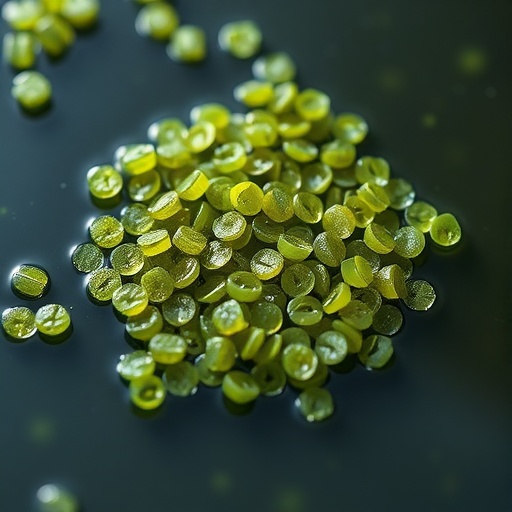In a groundbreaking study published in Environmental Science and Pollution Research, researchers N. Das and M. Nayak have made significant strides in enhancing the biomass and lipid productivity of the microalga Chlorella sp. BRE5. By optimizing phosphorus supply in a semi-continuous cultivation system, both in indoor and outdoor reactor setups, they have provided critical insights that could transform the landscape of biofuel production. This method demonstrates promising applications for agricultural sustainability and renewable energy.
Chlorella species are renowned for their high growth rates and impressive lipid production capabilities, making them prime candidates for biofuel applications. The ability to effectively cultivate these microalgae could ultimately play a key role in reducing our reliance on fossil fuels and mitigating the impacts of climate change. The research by Das and Nayak focuses specifically on the interplay between nutrient availability and algal productivity, which has been a key bottleneck in maximizing biomass outputs in previous studies.
Central to their findings is the concept of surplus phosphorus supply, which the researchers found significantly enhances both biomass and lipid production when implemented in a semi-continuous cultivation system. Phosphorus is a vital macronutrient that plays an essential role in cellular processes such as photosynthesis and energy transfer within microalgae. The judicious application of phosphorus—without reaching toxic levels—has thus emerged as a crucial factor in the cultivation strategy employed by the research team.
By implementing a semi-continuous mode of cultivation, the researchers were able to systematically harvest the algal biomass without interrupting growth cycles, enabling a more sustainable and efficient production process. This method not only maximizes the productivity of Chlorella sp. BRE5 but also provides a viable pathway for large-scale biofuel production. Utilizing indoor and outdoor reactor systems enables researchers to compare and analyze the effects of environmental variables on algal growth, leading to valuable data that could inform future cultivation practices.
The adaptability of Chlorella sp. BRE5 to various environmental conditions further underscores its potential as a biofuel feedstock. The study details experiments conducted under both controlled indoor conditions and variable outdoor environments, demonstrating the resilience of this microalga in less-than-ideal settings. Such findings are critical for developing robust cultivation systems that can thrive in a range of climatic conditions.
In examining the effects of phosphorus supply on lipid productivity, Das and Nayak underscored the importance of nutrient optimization in algal cultivation. The lipid-rich profile of Chlorella sp. BRE5 makes it particularly suited for biofuel applications, as lipids serve as the primary substrates for biodiesel production. The research revealed that judiciously increasing phosphorus levels led to a measurable enhancement in lipid yields, showcasing the potential benefits of nutrient-focused cultivation strategies.
An additional aspect of the mechanisms at play involves the relationship between light intensity and carbon dioxide availability in the reactor systems. The research highlighted that light penetration is critical for the photosynthetic performance of microalgae, and optimizing light conditions in tandem with nutrient supply can lead to significantly increased biomass production rates. This interplay between light, nutrients, and algal physiology plays a pivotal role in the cultivation methodologies recommended in this study.
Emerging trends in microalgal research indicate that large-scale application of algal biofuels could effectively contribute to global energy diversification. As fossil fuel reserves dwindle, alternative sources like microalgae offer a renewable and sustainable energy solution that aligns with global climate objectives. The enhancements proposed by Das and Nayak in Chlorella cultivation may serve as a benchmark for future biofuel research, pushing the boundary of what is achievable with algae-based systems.
Moreover, the implications extend beyond mere biofuel productivity. The use of microalgae as a biotechnological tool opens avenues for environmental remediation and nutrient recycling in agricultural settings. By integrating microalgal systems into farming practices, there lies the opportunity for utilizing agricultural waste, thus creating a circular economy that benefits both energy production and food security.
Looking ahead, the promising results from this research could drive further innovation in optimizing algal cultivation conditions. Future studies that build upon these findings might explore the genetic engineering of Chlorella species to enhance their lipid production traits, alongside continued efforts to improve sustainability practices in algal farming.
In conclusion, the study by Das and Nayak is a remarkable contribution to the field of algal biotechnology, promoting the cultivation of Chlorella sp. BRE5 through surplus phosphorus application in semi-continuous systems. Their findings highlight the strategic potential of microalgae in addressing global energy and environmental challenges, making a compelling case for further investment and research in this area.
As the quest for sustainable biofuel sources continues, Das and Nayak’s research provides a visionary perspective that could pave the way for transformative impacts across energy production and environmental stewardship. Their work underscores the pivotal role that nutrient management plays in optimizing algal biomass and lipid yields, reinforcing the notion that innovative approaches in cultivation can lead to ecological and economic benefits.
In summary, the pioneering study not only demonstrates impressive results but also stimulates critical discussions on the future trajectory of biofuels produced from microalgae. The work is likely to inspire additional research endeavors aimed at harnessing the full potential of Chlorella and other microalgae species for biofuel production within next-generation renewable energy solutions.
Subject of Research: Enhancing biomass and lipid productivity of Chlorella sp. BRE5 through phosphorus optimization
Article Title: Enhancing biomass and lipid productivity of Chlorella sp. BRE5 with surplus phosphorus supply implementing semi-continuous cultivation in the indoor and outdoor reactor system.
Article References:
Das, N., Nayak, M. Enhancing biomass and lipid productivity of Chlorella sp. BRE5 with surplus phosphorus supply implementing semi-continuous cultivation in the indoor and outdoor reactor system.
Environ Sci Pollut Res (2025). https://doi.org/10.1007/s11356-025-37059-y
Image Credits: AI Generated
DOI: 10.1007/s11356-025-37059-y
Keywords: Microalgae, Chlorella, Biofuel, Phosphorus Optimization, Cultivation Systems, Renewable Energy, Sustainable Agriculture




